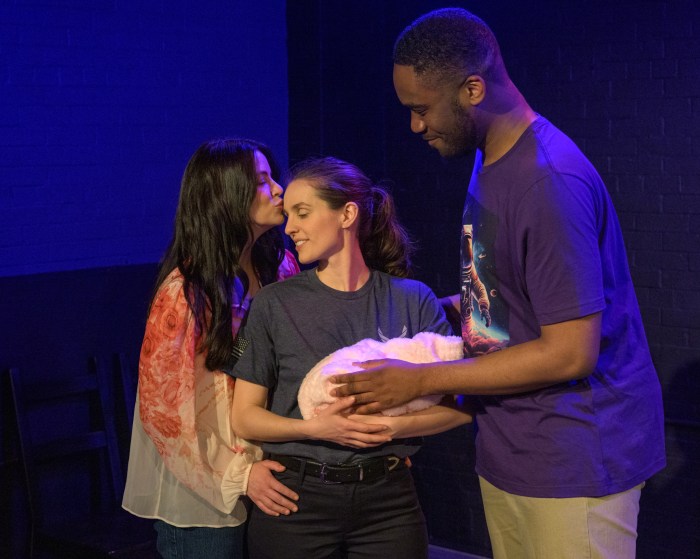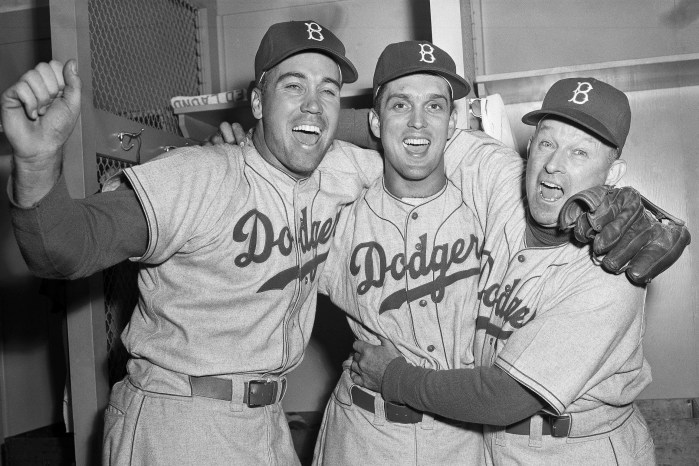What makes Canadian choreographer Aszure Barton’s work so appealing?
In four sold-out performances of her new “Busk,” presented at the Baryshnikov Arts Center (December 17-19), the choreographer explored the conflict between performers’ needs to put themselves on display and their simultaneous wish to remain private. That concept has major over-indulgence potential, but Barton deftly avoids the pitfall. She translates feeling into vivid, passionate kinetic imagery that challenges her dancers’ abundant skills as movers and actors, in the process taking us on a profoundly engaging journey.
Barton’s sterling troupe of nine, dressed in black sweat clothes and hoodies (by Michele Jank), devour space like fleet gazelles one moment and huddle together like frightened baby chicks the next. She persuades her dancers to strip naked psychologically; their physical commitment to her work is boundless. And the movement she creates in collaboration with them has uniquely inventive personality.
Aszure Barton’s buskers seek the limelight and their humanity
In the new Jerome Robbins Theater — a large, black box space — a curtain made of black feather boas (by creative design consultant Jon Morris) conceals the stage as the audience enters, and mist permeates the theater. A distant drumbeat, like that from a street show, rises and subsides, as if coming from somewhere outside.
When the house lights dim, Eric Beauchesne emerges from the front row and walks through a gap in the boa drapery, and the whole curtain immediately plummets to the ground. In a square of light that pierces the otherwise darkened space, Beauchesne becomes the street performer, doing his tricks and soliciting approval from us onlookers. His body folds into deep knee bends and stretches into long lunges; he occasionally grunts, as his white-gloved hands swirl and clap. He dons his hat, which sits on the floor in its own spotlight, by doing a headstand into it.
Similarly throughout, amazing solos are at once presentational and intimate, virtuosic and confessional. For hers, Cynthia Salgado doffs her baggy hoodie to reveal her lithe torso in a halter leotard; she ends her piece by crawling off on hands and knees, like the pet of the dark figure beside her. In his, African-American Jonathan Emanuell Alsberry bares his muscularly defined torso and inserts a little tap and hip hop.
Emily Oldak wears only a nude bikini as she arches into deep backbends and wraps her leg behind her neck like a contortionist, while her black-clad mates lie prostrate, hands outstretched, along the edges of her illuminated square. Charlaine Katsuyoshi creeps onstage inside a black garbage bag for her solo, which includes her wrapping herself in the boa like a fur coat and shimmying.
Barton’s exhilarating movement combines subtle gesture and extreme physicality, and Stephan Laks would seem to be her quintessential muse. With almost supernatural suppleness, he spirals his long torso in opposition to his legs, slides into wide splits, flips, and rolls. He begins his solo like a street mime, gloved hands swiping the air as if talking with his fingers; then he takes off in a physical barrage that leaves you breathless.
Barton integrates theatrical elements with an assured hand. Near the beginning, she puts the hooded dancers on a four-step riser; we see only their faces, darting in all directions, separately and in unison like a polyphonic choir.
Later, a mirror ball scatters speckles of light all around, while in the dimness a quartet tussles; they bark like trained seals. Nicole Pearce’s imaginatively theatrical lighting illuminates bodies in the darkness or floods the stage with warm washes or harsh front light that throws spooky shadows on the rear wall.
The wonderful musical score comprises recorded bits of choral music, a snatch of “Zip-A-Dee-Doo-Dah,” and electronic rumblings, but mostly comes from Ljova + the Kontraband, whose members are stationed in the rigging above the stage — Patrick Farrell on accordion; Mike Savino on double bass and banjo; and Mathais Kunzil on percussion. The director, violist Lev Zhurbin, plays along the sidelines or onstage. Their lively gypsy melodies reinforce the atmosphere of a traveling show. At one point, Inna Barnash stands up from a front row seat and sings a Yiddish song.
In the final scene, five dancers strip down to their bikini “skins,” symbolically baring their souls, while the others remain swathed in their blacks. Salgado, stripped, and Laks, clothed, alternate roles as master and pet as they slowly exit.
Even though the title and the action put you in mind of busking — street performing — Barton is also referring to the Spanish verb buscar, “to seek,” from which the term derives. The dancers are searching to resolve the dichotomy between public and private identities. As Barton contemplates the need felt by performers to make themselves public objects, her divine buskers thrill us with their dancing and enthrall us with their humanity.

































